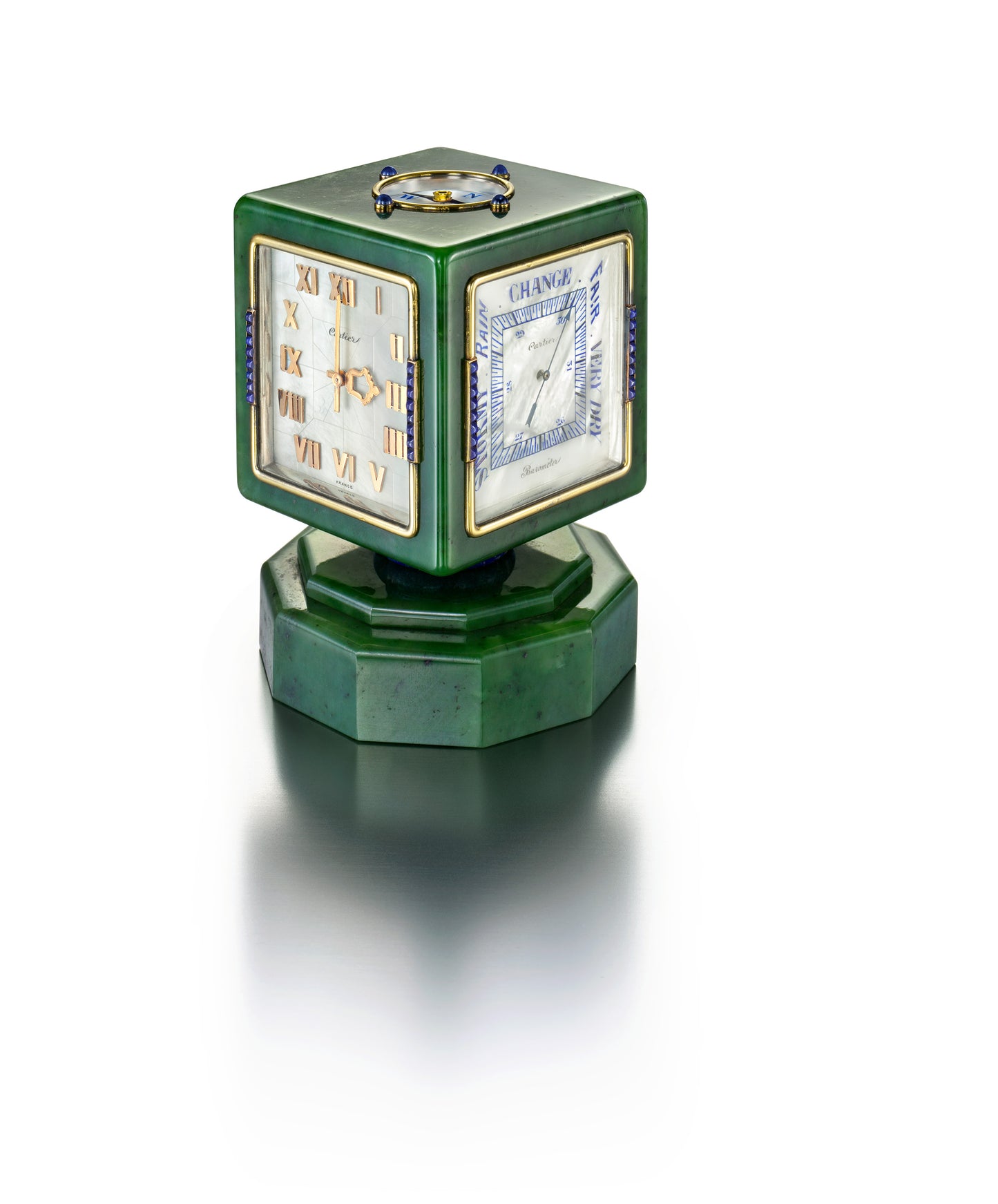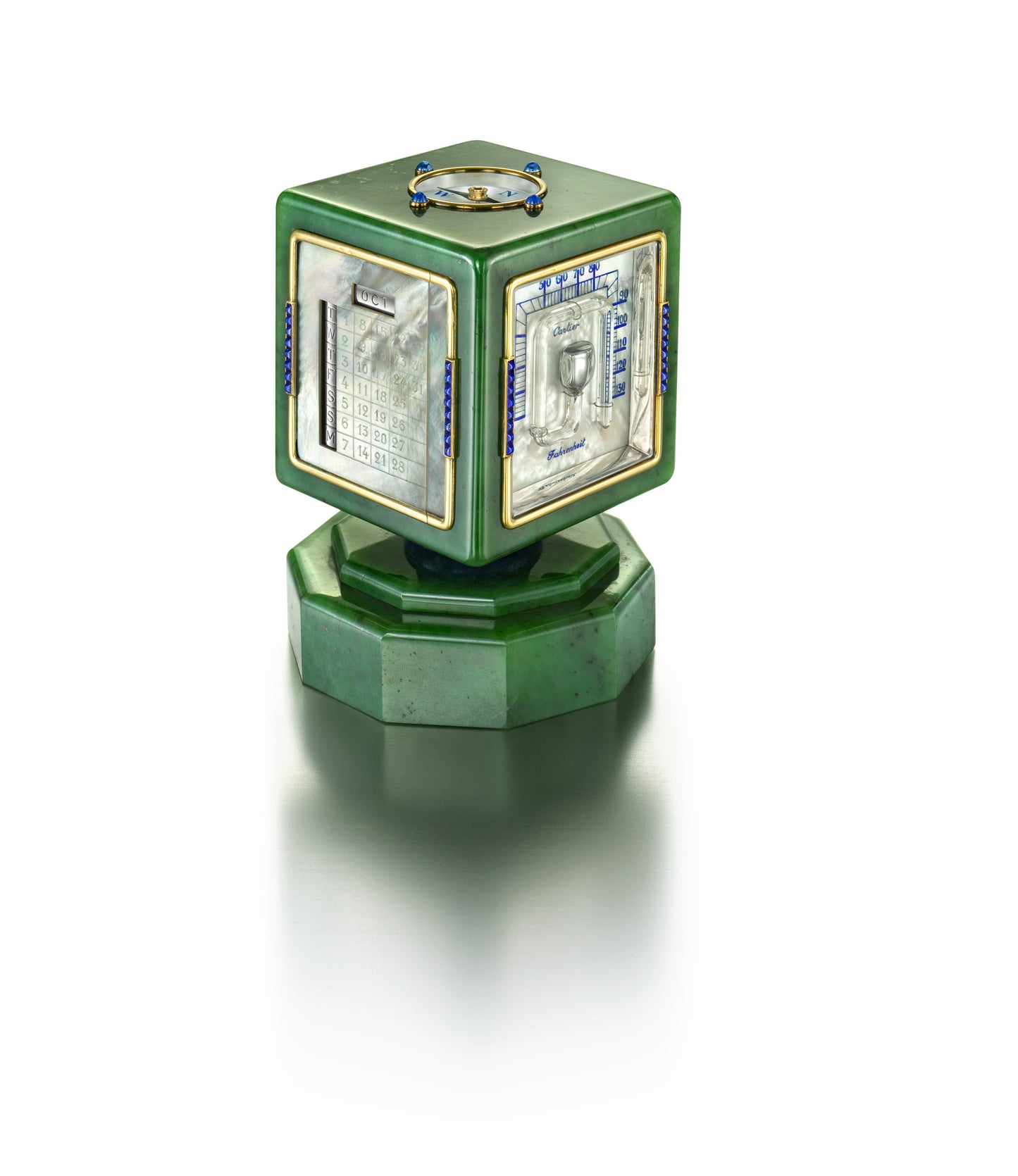ART DECO NEPHRITE JADE, SAPPHIRE, AND MOTHER-OF-PEARL REVOLVING DESK CLOCK WITH CALENDAR, BAROMETER, THERMOMETER, AND COMPASS BY CARTIER, CIRCA 1930
ART DECO NEPHRITE JADE, SAPPHIRE, AND MOTHER-OF-PEARL REVOLVING DESK CLOCK WITH CALENDAR, BAROMETER, THERMOMETER, AND COMPASS BY CARTIER, CIRCA 1930
SOLD
A clock of nephrite jade, each of the four sides inset with a mother-of-pearl face in a gold bezel decorated with a vertical row of calibré-cut sapphires on either side, comprising: a watch face with gold roman numerals and hands, a calendar, a barometer, and a thermometer-hydrometer, the top inset with a compass within a gold bezel quartered by round cabochon sapphires, the double decagonal base of carved nephrite surmounted by a lapis lazuli disc, the clock with 15 jewel movement, 3 adjustments; mounted in 18-karat gold; with original Cartier fitted red leather case
- Signed Cartier on the clock face; movement signed E.W.&C. Co. Inc, France, for European Watch & Clock Company
- Measurements: 3 7/16 × 3 7/16 × 4 3/8 inches
Additional cataloguing
Literature
Young-Sánchez, Margaret, et. al. Cartier in the 20th Century. New York: The Vendome Press, 2014, p. 101.
Exhibitions
- Brilliant: Cartier in the 20th Century, Denver Art Museum, Denver, November 16, 2014–March 15, 2015.
Biography
Cartier was founded in Paris in 1847 by Louis-François Cartier. His three grandsons, Louis, Pierre, and Jacques, built the house into a famous international jewelry empire serving royalty, Hollywood stars, and socialites. Cartier has created some of the most important jewelry and objects of art of the twentieth century with many iconic designs such as mystery clocks, Tutti Frutti jewelry and the Panthère line. In 1983, The Cartier Collection was established with the objective of acquiring important pieces that trace the firm’s artistic evolution. Today, Cartier has 200 stores in 125 countries.
Significance
While the legendary firm Cartier is mostly known for their exquisite jewelry, over the years they have created an array of beautiful objets d’art. Their repertoire includes a variety of objects such as carved figurines, desk accessories, boxes, picture frames, and timepieces. From the beginning, an important part of their business has been watches and clocks. Employing some of the greatest watchmakers and workshops, Cartier sought to make exceptional pieces that were exquisitely beautiful and made by the most skilled artists. Just as the Art Deco movement influenced their jewelry design following the First World War, so too did it affect the design of their clocks. Cartier’s greatest and most innovative clocks were created during the Art Deco period with the help of incredible watchmakers whose skills have been lost over time.
This table clock by Cartier elegantly combines the Art Deco style of boldness and modernity with function. In contrast to the delicate designs of the early 1910s and 1920s, this clock reflects the late Art Deco aesthetic of the 1930s. With its carved geometric nephrite jade sections accented by calibré-cut sapphires, the design of this clock evokes a bold and masculine look with its large size and smooth surfaces. Influence from the Far East, which was a popular theme during this period, is seen in the use of unusual carved hardstones such as nephrite jade and lapis lazuli. The function of the clock is found in the four different faces, which consist of a dial, calendar, barometer and thermometer-hydrometer, all accented at the top by a compass.
Each significant table clock Cartier created required multiple workshops to complete it. The various parts of this clock would have taken several experts and workshops to create and assemble this unusual combination of useful tools in a beautiful package. This table clock by Cartier is a rare and unique creation perfect for any collection.





